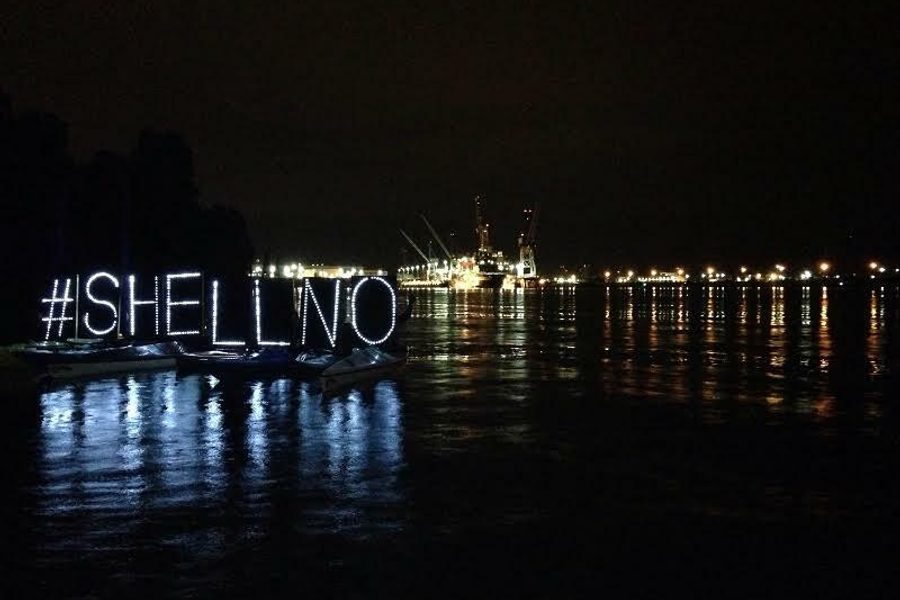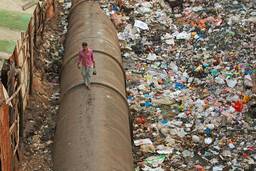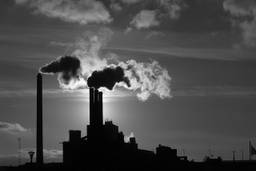How the Government Fast-Tracked Shell’s Arctic Drilling
After Royal Dutch Shell’s mishaps in the Arctic in 2012, the Obama administration indicated a major rethink of the approval process was in order—but instead, Shell got another rubber stamp.
Kamil Ahsan

Starting on July 29, 13 Greenpeace climbers spent 40 hours suspended from St. Johns Bridge in Portland, Ore., in an attempt to block Shell’s icebreaker, the MSV Fennica, from leaving for the Arctic.
The Fennica, one of the vessels in Shell’s 29-boat drilling fleet, was discovered earlier that month to have a 39-inch hole in its hull, which caused a ballast tank leak. The vessel was sent to Portland for repair. Despite the best efforts of Greenpeace blockaders, the mended icebreaker arrived in Alaska this week as part of Shell’s plans to drill exploratory wells in the Chukchi Sea this summer — plans approved by the Obama administration in May. The company announced yesterday that it is ready to drill as soon as it receives the final government go-ahead.
The protests in the Pacific Northwest, along with protests by the Iñupiat community of the Alaskan Arctic, underscore just how much the Obama administration’s approval of Shell’s Arctic drilling plans has incensed environmental and indigenous groups.
Shell has a disastrous record in the Arctic. In the summer of 2012, the last time the oil giant was approved to undertake exploratory offshore drilling, one rig, the Kulluk, ran aground near Kodiak, Alaska. The Coast Guard found that Shell had sent the rig out with “inadequate assessment and management of risks.” Another vessel, which had previously failed to secure permission for drilling, ran adrift in Dutch Harbor, was forced to detach from the seafloor and subsequently caught fire.
Shell and the contractors of its drilling rigs have since been embroiled in legal battles. The EPA found that both the Kulluk and another rig, the Noble Discoverer, violated multiple Clean Air Act standards. In another suit, the Shell contractor that operated the rigs was fined $12.2 million for breaking environmental and maritime law. Furthermore, a review of Shell’s 2012 program found that it had inadequately tested equipment for containment in the event of a spill.
Opponents of drilling argue that such a record indicates how woefully underprepared Shell is for its Arctic undertakings, and that even though a major spill did not occur in 2012, the chances of one in any future drilling endeavor are extremely high.
Furthermore, environmental groups question the rationale of an administration that, while cognizant of “the rapid loss of Arctic summer ice,” continues to support the extractive drilling practices responsible for the climate change that accelerates that loss.
Moreover, extractive drilling and accelerated climate change demonstrably threaten the livelihoods, health and subsistence of the Iñupiat community. Increasingly, Iñupiats face respiratory problems and other ailments as a result of proximity to oilfields. Many villages also face the prospect of relocation due to the massively accelerated loss of sea ice, as well as the major changes in their subsistence whaling and hunting practices because of the profound impacts climate change and extractive drilling have had on wildlife.
For environmental groups and the indigenous Iñupiat, this year’s approval seems part of a long trend of Obama’s regulatory agencies rubberstamping offshore drilling.
And indeed, even as Obama campaigned on sustainability and a global response to climate change, critics have pointed out the administration’s eagerness to open the Arctic to drilling.
“When Obama took office,” explains Subhankar Banerjee, environmental activist and author of Arctic Voices: Resistance at the Tipping Point, “he made opening of the Arctic Ocean to oil interests a top priority of his energy policy, which of course was immensely inconsistent with his positions. He has not backed off on that.”
“What the administration, in essence, has done,” says Banerjee, “is something the Bush administration would have done, but perhaps worse.”
On close inspection, a long and sordid tale of collusion emerges between Shell executives and federal regulatory agencies in the Obama administration, in charge of approving exploratory drilling plans on Shell’s leases in the Chukchi Sea. This relationship, it seems, relied on avoiding any comprehensive review of the environmental and wildlife impacts of offshore drilling in the harsh climate of the Arctic.
Lessons in collusion
Back in 2012, after the Bureau of Ocean Energy Management (BOEM), an agency in the approved the summer expedition that would ultimately lead to the Kulluk disaster, an investigative report in the New York Times detailed just how the approval of Shell’s exploratory drilling plans had been managed.
To get the approval so soon after the 2010 Deepwater Horizon disaster in the Gulf of Mexico, Shell launched a massive two-pronged campaign. The first was a corporate charm offensive to target Shell’s wiliest enemies: the indigenous Iñupiat community, which, along with environmental groups, has a long history of suing to block Shell’s drilling plans. Company executive, Pete Slaiby, travelled to Iñupiat villages and wooed them to the cause of extractive drilling by handing out raffle tickets, serving food and joining in Native dances.
But according to the Times, Shell’s most powerful lever was government lobbying. Top Shell lobbyists visited the White House at least 19 times in the first three years of Obama’s presidency. Among them were several retired senators. All the while, the company sent a steady flow of “visits, letters and calls to the agencies that could grant or deny the myriad permits it needed in the Arctic,” writes the Times. In 2011 alone, Shell spent $14.8 million in lobbying costs.
From Shell’s point of view, the investment appears to have been a good one: The DOI approved the drilling in 2012 with only a cursory look at potential environmental impacts. BOEM declared it unnecessary to do an Environmental Impact Statement (EIS), which would have required thorough investigations into climatic and wildlife impacts, a public comment period, and a consideration of possible alternatives. The DOI considered only a best-case scenario that “skews the data toward fewer environmental impacts and thus impedes a full and fair discussion of the potential effects of the project,” according to a Court of Appeals for the Ninth Circuit verdict on a lawsuit filed by Earthjustice.
As Banerjee wrote at the time, avoiding an EIS was tantamount to the federal government saying, “If we do an appropriate and thorough scientific study of the Beaufort and Chukchi seas we might find out that Shell shouldn’t really go there to drill.”
Greasing the wheels (again)
In the aftermath of the revelations of 2012, Shell and the DOI indicated a major rethink was required.
In a statement, Shell said that it would “take the findings [on the Kulluk] seriously” and had implemented “lessons learned” from the incident.
Interior Secretary Ken Salazar insisted that “Shell will not be able to move forward into the Arctic to do any kind of exploration unless they have this integrated management plan put in place,” adding that “the government still has a lot to learn.”
The director of the federal agency charged with enforcing environmental regulation, the Bureau of Safety and Environmental Enforcement (BSEE), stated that “BSEE will continue its unprecedented oversight of drilling activities and…continue to hold anyone operating in public waters to the highest safety and environmental standards.”
But Arctic oil drilling remained on the table. In May 2013, Obama’s National Strategy for the Arctic Region reaffirmed his commitment to drilling in the Arctic, stating the need to “make the most of the emerging economic opportunities in the region.”
Behind the scenes, the cozy ties between Shell, company lobbyists and government regulators continued. Shell spent $9 million in 2013 and $8 million in 2014 on lobbying. Meeting records and correspondence obtained by Greenpeace in a Freedom of Information Act request show that Shell and BOEM regulators held backroom meetings between March and May 2014, well before a key environmental review was finalized — at a time when BOEM was not officially allowed to accept plans on Shell’s Chukchi lease.
Notes from one such meeting, on May 27, 2014, revealed that BOEM regulators told Shell executives that they saw a federal district court’s approval of Shell’s environmental review as a surefire deal. This meeting took place well before BOEM made its own decision.
While regulators had Shell’s ear for 12 months, the public comment period lasted only 21 days, from April 10 to May 1.
Shell launched a similar campaign in Washington state, where a robust debate has been underway concerning permits for the Port of Seattle to host Shell’s drilling fleet. As Eric de Place, policy director and researcher at Sightline Institute, has reported, Shell’s political spending in Washington state is often remarkably hard to track.
The state allows corporations to anonymize campaign donations by routing them through local lobbyist firms. In this way, Shell has secretively given more than one hundred thousand dollars to legislators in Washington state — but it is difficult to determine whom.
“This is a big corporate powerhouse spreading its influence, and the public has no opportunity to see what’s going on,” says de Place.
A rethink rethought
Clearly, as part of the broader policy of an administration bent on opening up the Arctic for offshore drilling, public opinion has been largely sidestepped in favor of a close — and secretive — government relationship with Shell.
So it may be no surprise that the rethink apparently never happened. Indeed, environmental groups argue that this year’s approval of Shell’s Arctic plans wasn’t so different from 2012’s. They say that again, regulators failed to do a complete environmental analysis or risk assessment before giving the project the green light, essentially colluding with Shell to fast-track its drilling.
BOEM once again found no need for a comprehensive EIS and insisted that “the Proposed Action would not cause any significant impacts.”
What’s more, BSEE has allowed Shell to go ahead with a drilling plan that was not a part of the BOEM-approved exploration plan, or considered in the short internal Environmental Assessment (EA) report produced by BOEM, despite calls by environmental groups for a complete re-evaluation.
According to Tim Donaghy, a senior research specialist at Greenpeace, “The government really needs to rescind [Shell’s exploratory plan] and go back to the drawing board. Instead, they seem to be improvising in order to help Shell overcome its own mistakes.”
To take just another example, as part of the administration’s renewed commitment to more oversight and higher standards, the DOI had recommended in 2012 that any subsequent proposal by Shell be reviewed by a third-party auditor in order to provide independent oversight of Shell’s plans before it could be allowed into the Arctic.
In May of this year, however, soon after the approval of Shell’s plans, BSEE admitted to The Guardian that the key third-party auditor required for the permit was handpicked and paid for by Shell.
The identity of the auditor, and the results of the audit itself, remain secret. A FOIA request filed by Greenpeace to obtain details was recently denied. According to Donaghy, “Shell claimed that the entire report constituted ‘confidential business information.’ The government reviewed [Shell’s] claim and agreed with them.”
BSEE has reassured the public that the auditor, despite being hired by Shell, met the agency’s standards. But that is far from reassuring.
“Apparently the report for the audit was only five pages long,” says Donaghy. “We have a lot of questions about how true it was, and whether it was a real audit or just a rubberstamp.”
“All the public has to rely on,” he continues, “are soothing statements from Shell’s spokesperson about how they have learned their lessons from 2012.”
In some ways, the bar for this year’s approval may well been even lower than in 2012. “The regulatory processes has actually gotten weaker,” explains Donaghy, citing a 2011 law sponsored by Senator Lisa Murkowski (R-Alaska) that went into effect in 2013, shifting responsibility for regulating air quality from the EPA and to BOEM. Sen. Murkowski’s biggest donor in 2011-2012 was Edison Chouest Offshore, the contractor that built Shell’s failed Kulluk Rig.
This has meant a huge drop in the air quality standards Shell must meet. Under EPA regulations, Shell has to meet Clean Air Act standards — any drilling operation that is estimated to emit at least 250 tons of a pollutant annually must install the best pollution control technology available. In contrast, BOEM merely asks for an estimate of how much air pollution drilling operations will cause and whether or not it will have a significant impact.
Perhaps even more critically, under the Clean Air Act, the EPA would require Shell to account for pollution from all vessels involved in the drilling operation. DOI regulations, on the other hand, would not require Shell to report emissions from support vessels and emergency equipment.
“That’s just one aspect where lots of players in the government have greased the wheels for this project to go ahead,” says Donaghy.
In other words, BOEM has done absolutely nothing to make Shell learn from the mistakes of 2012, and almost everything to fast-track its drilling plans in the Chukchi Sea.
The ongoing misadventures of Shell
Despite the lack of government oversight, Shell executives maintain that they are now much better prepared for exploratory oil drilling operations.
The early hiccups tell a different story.
The MSV Fennica, which developed a gash in its hull, is a critical component of Shell’s drilling fleet because it carries a critical “capping stack” mechanism that serves as Shell’s primary containment strategy. Shell insists that in the event of a damaged well and an oil spill, a capping stack ‘dome’ placed on top of the well would be sufficient to prevent a full-blown oil spill.
Shell spokesperson Curtis Smith maintains that “in no way does [the 2015 leak] characterize the preparations we have made to operate exceptionally well.”
The Obama administration, too, seems unperturbed, and has given critical final permits, even while environmental groups like Greenpeace call for a complete re-evaluation of the drilling proposals.
“It is clear,” said Donaghy, “that despite all the happy talk from the government, they haven’t solved any of their problems.”
Undeterred by its continuing mishaps, however, Shell is powering full steam ahead with its plans — helped by federal regulators. The oil giant recently managed to secure a key animal disturbance permit, despite a long history of disruption to local Arctic wildlife, including the migration patterns of beluga and bowhead whales, and the diminishing populations porpoises, seals, polar bears and walruses.
As the accidents accumulate, however, they have drawn attention to to a robust public opposition movement made up of indigenous communities, activists and environmental groups. Their direct action tactics have ensured that Shell’s misadventures and continuing designs on the Arctic are catching many people’s attention.
Environmental groups that feel strongly about the impact extractive drilling in the Arctic will have on increasing fossil-fuel dependency and a deepening climate crisis, as well as indigenous groups that are facing immediate threats to their subsistence and livelihoods, continue to point out the inconsistency of an administration that pays lip service to tackling climate change while supporting the extractive drilling practices that are responsible for climate change in the first place.
The protest movement, it seems, continues to gain potency with every mishap. It is for this reason that those fed up with the enormous political power of Royal Dutch Shell and complicit federal regulators may soon have reason to cheer. After all, as Banerjee told In These Times, cheekily, in reference to Shell’s fruitless quests for oil in the Arctic in the 1990s: “The first wave of Arctic offshore development resulted in a bust for Shell. Who knows what might happen in this second wave?”







